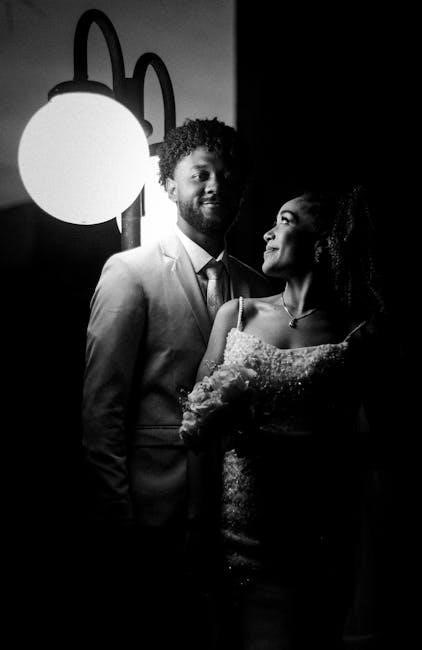outdoor lighting placement guide
Proper outdoor lighting placement enhances safety, ambiance, and functionality while ensuring energy efficiency. This guide offers expert tips on positioning fixtures to maximize their impact and durability. Learn how to illuminate your space effectively with strategic placement and thoughtful design considerations.
Importance of Proper Outdoor Lighting Placement
Proper outdoor lighting placement is crucial for safety, security, and aesthetics. It illuminates walkways, preventing accidents and guiding visitors. Strategic placement deters intruders by eliminating shadows. Well-designed lighting highlights architectural features and enhances curb appeal. Additionally, it ensures energy efficiency by minimizing light waste. Improper placement can lead to glare or inadequate coverage, reducing effectiveness. By thoughtfully positioning fixtures, you create a welcoming, functional, and secure outdoor space that balances beauty and practicality.
Overview of Key Considerations
When planning outdoor lighting, several factors must be considered to ensure optimal results. The purpose of the lighting, such as safety, security, or aesthetics, dictates fixture selection and placement. The layout of the space, including pathways, gardens, and structures, influences where lights should be installed. Lighting levels must balance brightness and energy efficiency, avoiding excessive glare. Weather-resistant materials are essential for durability. Additionally, budget and maintenance needs should be evaluated. Creative techniques, like layering light sources, can enhance the overall design. Proper planning ensures a functional, visually appealing, and sustainable outdoor lighting system tailored to your specific needs and environment.

Understanding Different Types of Outdoor Lighting
Outdoor lighting includes pathway, security, accent, flood, and deck lighting. Each type serves unique purposes, enhancing safety, aesthetics, and functionality for specific outdoor spaces and needs.
Pathway Lighting
Pathway lighting is essential for safety and ambiance, illuminating walkways, driveways, and garden paths. It helps guide visitors and prevents tripping hazards in low-light areas. Common fixtures include bollards, ground lights, and solar-powered stakes. Placement should be spaced evenly, typically 8-10 feet apart, to ensure consistent light coverage. Fixtures should be positioned at a slight angle to avoid glare and directed downward for optimal illumination. Choose designs that complement your outdoor aesthetic, such as modern sleek styles or traditional lanterns. Consider energy-efficient options like LED or solar lights for cost savings. Proper installation ensures both functionality and visual appeal, enhancing your home’s exterior.
Security Lighting
Security lighting is a crucial element for deterring intruders and enhancing visibility around your property. It should be strategically placed in areas vulnerable to breaches, such as entry points, garages, and dark corners. Motion-sensitive lights are ideal as they activate upon detecting movement, providing both security and energy efficiency. Floodlights and spotlights are commonly used for their wide coverage and powerful illumination. Ensure fixtures are installed at optimal heights to avoid glare and maximize visibility. Solar-powered options are eco-friendly and reduce wiring needs. Regular maintenance is essential to ensure reliability. Proper placement and bright, focused light beams can significantly enhance your home’s safety and security.
Accent Lighting
Accent lighting is designed to draw attention to specific features in your outdoor space, such as landscaping, architectural details, or decorative elements. It creates visual interest and enhances the aesthetic appeal of your property. Common techniques include uplighting to highlight trees or sculptures and downlighting to create pools of light on walkways or seating areas. Backlighting can also be used to silhouette plants or structures, adding depth and drama. When placing accent lights, consider the desired focal points and ensure fixtures are positioned to avoid harsh glare. Energy-efficient options like LED lights are ideal for accent lighting, offering long-lasting performance and minimal maintenance.
Flood Lighting
Flood lighting provides broad, intense illumination over large areas, making it ideal for driveways, parking lots, and security applications. These fixtures are often mounted high on walls or poles to cover extensive spaces. Proper placement ensures maximum coverage while minimizing glare. Position floodlights to face downward and away from windows to avoid light spill. For security purposes, aim them at vulnerable areas like gates or entry points. Ensure the lighting level matches the space’s needs, balancing brightness for visibility without over-illumination. Energy-efficient LED floodlights are recommended for their durability and low maintenance. Always consider local lighting regulations to avoid excessive light pollution.
Deck and Patio Lighting
Deck and patio lighting enhances outdoor living spaces by providing warm, inviting ambiance and ensuring safety. Position lights near seating areas, steps, and railings to highlight features and prevent accidents. Solar-powered or low-voltage fixtures are popular for their energy efficiency and ease of installation. Consider recessed lighting for a sleek look or string lights for a cozy vibe. Weather-resistant materials are essential for durability. Aim to create a balance between ambient and task lighting to illuminate both social areas and pathways. Proper placement ensures functionality while adding aesthetic appeal, making your deck or patio a welcoming extension of your home.

Factors Influencing Outdoor Lighting Placement
Outdoor lighting placement is influenced by purpose, location, lighting levels, and energy efficiency. Balancing functionality with aesthetic appeal ensures safety, visibility, and durability in various settings.
Purpose of the Lighting
The purpose of outdoor lighting determines its placement and design. Whether for safety, ambiance, or functionality, understanding the primary goal ensures effective illumination. Security lighting prioritizes visibility and deterrence, often placed near entry points and dark areas. Ambient lighting creates a welcoming atmosphere, ideal for pathways and gardens. Task lighting, such as deck and patio lights, focuses on specific areas for activities. Aesthetic lighting highlights architectural or landscape features, enhancing visual appeal. Combining these purposes requires strategic planning to balance functionality and beauty. Each purpose dictates fixture type, brightness, and placement, ensuring the lighting meets its intended use while complementing the overall design.
Location and Layout of the Space
The location and layout of your outdoor space significantly influence lighting placement. Consider the terrain, pathways, and key features like gardens or water elements. Lighting should be positioned to highlight these areas while ensuring even coverage. For pathways, lights are typically spaced evenly to guide movement. Gardens and landscaping may require accent lights to emphasize specific plants or structures. Entry points like doors and gates need bright, focused lighting for safety and visibility. The layout also affects cable routing and fixture installation, especially in uneven or sloped areas. Understanding the space’s unique characteristics ensures lighting is both functional and aesthetically pleasing, adapting to its natural and built elements.
Lighting Levels and Brightness
Lighting levels and brightness are critical for functionality and ambiance in outdoor spaces. The intensity of light should align with the space’s purpose—task areas like walkways require higher brightness, while ambient spaces like gardens need softer illumination. Overly bright lights can create glare and energy waste, while insufficient lighting may compromise safety. Consider the natural light available and how artificial lighting complements it. Energy-efficient options like LED lights offer adjustable brightness, allowing you to customize lighting levels without excessive energy consumption. Proper brightness ensures your outdoor space is both inviting and functional, balancing aesthetics with practical needs for safety and usability.
Energy Efficiency and Cost
Energy efficiency and cost are essential considerations in outdoor lighting placement. LED and solar-powered lights are popular choices due to their low energy consumption and long lifespan. Solar lights, in particular, offer a cost-effective solution as they rely on renewable energy, reducing electricity costs. Motion sensors and timers can further optimize energy use by activating lights only when needed. While initial installation costs may vary, energy-efficient options often lead to long-term savings. Additionally, many utility companies provide rebates for energy-efficient lighting installations. Balancing upfront costs with long-term energy savings ensures a sustainable and budget-friendly outdoor lighting system that minimizes environmental impact while maintaining functionality and aesthetics.

Choosing the Right Fixtures for Your Needs
Selecting the right outdoor lighting fixtures involves considering wired, wireless, or solar options. Durable materials and weather-resistant designs ensure longevity. Choose fixtures that align with your budget and specific needs to enhance functionality and aesthetics.
Wired vs. Wireless Lighting
When deciding between wired and wireless lighting, consider reliability, installation complexity, and flexibility. Wired systems offer consistent power and brightness but require professional installation and are less adaptable to layout changes. Wireless options, often solar-powered, provide ease of installation and portability but may vary in performance due to weather and battery life. Evaluate your energy needs, budget, and desired level of maintenance to choose the best option for your outdoor space. Each type has unique benefits, so align your choice with your specific lighting goals and preferences.
Solar-Powered Lighting Options
Solar-Powered Lighting Options
Solar-powered lighting is an eco-friendly and cost-effective solution for outdoor spaces. These lights harness sunlight during the day and provide illumination at night, eliminating electricity costs. Ideal for pathways, gardens, and patios, solar lights are easy to install without wiring, offering flexibility in placement. However, their performance depends on sunlight exposure, so consider placement in sunny areas. Many solar options are weather-resistant and durable, making them low-maintenance. With advancements in technology, solar lights now offer bright, long-lasting illumination. They are a sustainable choice for those seeking energy efficiency and reduced environmental impact; Explore solar-powered options for a practical and eco-conscious lighting solution.
Weather-Resistant and Durable Fixtures
Weather-resistant and durable fixtures are essential for outdoor lighting, as they withstand harsh environmental conditions. Look for materials like stainless steel, brass, or aluminum, which are known for their resilience against rust and corrosion. Fixtures with protective coatings or finishes, such as powder-coated or galvanized surfaces, offer additional durability. Ensure the lighting is rated for outdoor use, with features like UV-resistant finishes and sealed housings to prevent water and moisture damage. These fixtures maintain their appearance and functionality over time, even in extreme weather. By selecting weather-resistant options, you can enjoy long-lasting illumination while minimizing maintenance and replacement needs, ensuring your outdoor space remains well-lit and safe year-round.
Outdoor Lighting Placement Tips
Strategic placement of outdoor lighting enhances safety, ambiance, and functionality. Position fixtures to illuminate key areas like pathways and entry points, ensuring even light distribution while minimizing glare. Use directional lighting for focal points and consider energy-efficient options to reduce long-term costs. Proper placement not only improves visibility but also highlights your home’s exterior features, creating a welcoming atmosphere for both residents and visitors. By thoughtfully planning your lighting layout, you can achieve a balance between aesthetics and practicality, ensuring your outdoor space remains well-lit and inviting year-round.
Pathway Lighting Placement
Pathway lighting is essential for safety and aesthetics, guiding foot traffic while enhancing your outdoor space. Position lights 6-8 feet apart along walkways, adjusting based on fixture output. Install them closer together on stairs or uneven terrain for added safety. Place lights at ground level or slightly above, ensuring they illuminate the path without causing glare. Solar-powered options are eco-friendly and easy to install. Use a consistent style and spacing to maintain a cohesive look. Consider the width of the path and the height of surrounding plants when selecting fixtures. Proper placement ensures even light distribution, creating a welcoming and secure environment for nighttime navigation.
Security Lighting Installation
Security lighting is crucial for deterring intruders and enhancing visibility. Install motion-activated lights near entry points, garages, and dark corners to maximize coverage. Position fixtures 8-10 feet above the ground to prevent tampering and ensure wide illumination. Angle lights downward to avoid glare and focus beams on vulnerable areas like windows and doors. Use weather-resistant fixtures with a high lumens rating for optimal brightness. Consider solar-powered options for energy efficiency. Avoid overlighting to maintain a balance between security and aesthetics. Regularly test sensors and adjust settings to minimize false triggers. Ensure lights are positioned to cover blind spots without obstructing natural pathways. Always follow local regulations and safety guidelines during installation.
Accent Lighting Techniques
Accent lighting highlights specific features in your outdoor space, creating visual interest and depth. Use spotlights or uplighting to illuminate trees, sculptures, or architectural details. Place fixtures at ground level, angling them upward to emphasize textures and shapes. For water features or gardens, submersible lights or directional spotlights can enhance beauty. Consider cross-lighting for statues or large plants to create dramatic effects. Ensure fixtures are weather-resistant and positioned to avoid glare. Use adjustable beams to focus light precisely. Install timers or smart controls to customize lighting effects for different times of day. Balance accent lighting with ambient light to maintain functionality while showcasing design elements;
Flood Lighting Positioning
Flood lighting provides broad, intense illumination for large areas like yards, driveways, or commercial spaces. Position flood lights at elevated points, such as roof eaves or tall poles, to maximize coverage. Aim the lights downward to minimize glare and ensure even distribution. Place them strategically to cover entryways, parking areas, or sports courts. Use wide-beam angles for expansive coverage or narrow angles for focused lighting. Ensure fixtures are weather-resistant and securely installed. Consider timers or motion sensors to optimize energy use. Avoid pointing flood lights toward windows or neighbors to prevent light pollution. Proper positioning enhances safety, visibility, and functionality while reducing unwanted light spillage.
Deck and Patio Lighting Ideas
Deck and patio lighting enhances outdoor living spaces by creating ambiance and ensuring safety. Use LED lights or solar-powered fixtures to minimize energy costs. Place lights under railings, stairs, or built into decking for a sleek look. String lights or lanterns add a cozy, decorative touch. In-ground lights along the perimeter provide subtle illumination. Consider motion sensors for automatic activation. Weather-resistant fixtures are essential for durability. For pools or water features, submersible lights create a dazzling effect. Combine task lighting for cooking areas with ambient lighting for seating spaces. Layered lighting designs ensure functionality and aesthetics, transforming your deck or patio into an inviting outdoor retreat for relaxation and entertainment.

Measuring and Spacing Guidelines
Measure spaces carefully to ensure proper lighting coverage. Calculate spacing based on fixture type and brightness. Use tools like tape measures and level tools for accuracy. Plan layouts to avoid overlighting or dark spots, ensuring energy efficiency and safety.
Calculating the Right Spacing for Pathway Lights
Proper spacing for pathway lights ensures even illumination and safety. Start by determining the light’s spread and brightness. For walkways, space lights 10-15 feet apart; for steps, 6-8 feet. Use a spacing formula: distance = √lumens. For 200-lumen lights, space them 14 feet apart. Adjust based on beam angle and desired ambiance. Check manufacturer specs for specific recommendations to avoid overlighting or dark spots, ensuring energy efficiency and functionality while creating a welcoming atmosphere for your outdoor space.
Determining the Height for Wall-Mounted Fixtures
When installing wall-mounted outdoor lighting, the height is crucial for functionality and aesthetics. Fixtures are commonly installed between 9 and 12 feet above the ground to ensure proper illumination and reduce glare. For single-story buildings, 9-10 feet is ideal, while taller structures may require 12 feet or more. Consider the light’s purpose: security lights benefit from higher placement for broader coverage, while accent lights are placed lower to highlight features. Always check manufacturer guidelines for specific height recommendations. Ensure the light is shielded to avoid direct eye contact, creating a balanced and visually appealing outdoor space that is both safe and energy-efficient.
Measuring Distance for Floodlights
Measuring the distance for floodlights is essential for optimal coverage and brightness. Typically, floodlights are installed 15 to 30 feet away from the target area, depending on their wattage and lumen output. Higher mounting heights allow the light to reach farther, illuminating larger spaces. For security purposes, consider overlapping the light patterns to eliminate dark spots. Use the beam angle to determine the spread: narrower angles focus light over distance, while wider angles cover more area. Always refer to the manufacturer’s specifications for precise distance recommendations to ensure effective and energy-efficient illumination. Proper placement enhances safety and visual appeal in outdoor spaces.

Installation and Maintenance
Proper installation ensures functionality and safety, while regular maintenance extends the lifespan of outdoor lighting. Follow manufacturer guidelines for wiring and placement to avoid issues. Clean fixtures and replace bulbs as needed to maintain brightness and efficiency. Troubleshoot common problems promptly to ensure consistent performance and longevity of your lighting system.
Step-by-Step Installation Guide
Begin by planning your outdoor lighting layout, ensuring fixtures are placed strategically for optimal coverage. Turn off the power supply at the circuit breaker before starting. Dig shallow trenches for cables if necessary, using a shovel or trenching tool. Lay the cables carefully, avoiding sharp bends. Install fixtures by securing them to the ground or mounting surfaces, following the manufacturer’s instructions. Connect the wiring, ensuring all connections are waterproof and secure. Test each light to confirm proper function. Turn the power back on and adjust fixtures as needed for alignment and brightness. Finally, cover trenches and clean up the area for a polished finish.
Regular Maintenance Tips
Regular maintenance ensures your outdoor lighting remains functional and visually appealing. Clean light fixtures and lenses periodically to remove dirt and debris that can dim brightness. Inspect wiring and connections for signs of wear or damage, especially after extreme weather conditions. Replace burned-out bulbs promptly, opting for energy-efficient LED options for longevity. Trim nearby foliage to prevent obstruction of light beams. Check for any loose fixtures and tighten them as needed. Schedule annual inspections to assess system performance and make necessary adjustments. Addressing issues early prevents costly repairs and ensures consistent lighting quality throughout the year.
Troubleshooting Common Issues
Common issues with outdoor lighting include flickering lights, uneven illumination, or fixtures not turning on. Check connections for looseness or corrosion, especially after wet weather. Replace faulty bulbs or sensors promptly. If lights flicker, ensure bulbs are securely screwed in and compatible with fixtures. For motion-sensitive lights, adjust sensitivity settings to avoid false triggers. Clean dirt from sensors and lenses to maintain functionality. Address electrical issues by resetting circuit breakers or consulting a professional. Regularly inspect wires for damage from pests or weather. Adjust fixture angles to achieve desired light distribution. For LED lights, ensure dimmers are compatible to avoid flickering. Resolve issues early to maintain performance and safety.
Proper outdoor lighting placement enhances beauty and safety. Consider purpose, layout, and energy efficiency for optimal results. Apply these strategies to create a welcoming ambiance and explore creative solutions for future projects.
Summarizing Key Placement Strategies
Effective outdoor lighting placement begins with defining the purpose, whether for safety, aesthetics, or functionality. Pathway lights should be spaced evenly to ensure visibility and ambiance, while security lights need strategic positioning to cover vulnerable areas. Accent lighting highlights specific features, and floodlights are best placed to cover larger spaces. Consider the layout of your outdoor space, ensuring fixtures complement the design. Measure distances and heights precisely, and opt for energy-efficient, weather-resistant options. Regular maintenance is crucial to uphold performance and safety. By combining these strategies, you can create a well-lit, inviting, and secure outdoor environment that enhances both beauty and functionality.
Encouraging Creative Lighting Solutions
Creativity is key to transforming your outdoor space into a unique and inviting environment. Consider layering light types, such as combining pathway lights with accent fixtures, to create depth and visual interest. Experiment with color temperatures and directional lighting to highlight architectural features or landscaping elements. Incorporate decorative fixtures that reflect your personal style, whether modern, rustic, or minimalist. Don’t hesitate to mix wired and wireless solutions for flexibility. Adding timers or smart controls can enhance functionality while maintaining aesthetic appeal. By thinking outside the box, you can craft a lighting design that not only illuminates but also inspires, turning your outdoor space into a breathtaking oasis.

Additional Resources
Explore recommended guides, expert tips, and professional consultation options to enhance your outdoor lighting knowledge and inspiration for creating a well-lit space.
Recommended Reading and Guides
For further insights, explore comprehensive guides on outdoor lighting placement, offering expert tips and detailed strategies. These resources cover fixture selection, energy-efficient solutions, and maintenance best practices. Discover how to create functional and aesthetically pleasing spaces with step-by-step instructions; Additionally, find inspiration from case studies and real-world examples showcasing successful lighting designs. Whether you’re a homeowner or a professional, these guides provide valuable knowledge to enhance your outdoor lighting projects. They often include troubleshooting tips and creative ideas to maximize your setup’s potential while ensuring safety and durability.
Professional Consultation Options
For complex outdoor lighting projects, consider consulting with a professional. Landscape architects, lighting designers, or electricians can provide tailored solutions, ensuring both functionality and aesthetics. They assess your space, recommend fixtures, and optimize placement for energy efficiency and safety. Professional consultations are ideal for large properties, unique layouts, or high-budget projects. Many experts offer free initial consultations, allowing you to discuss your vision and budget. Check reviews and certifications to find a reliable specialist. Their expertise can elevate your outdoor space, ensuring long-term durability and visual appeal while adhering to local regulations and safety standards.